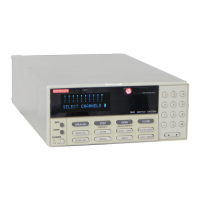IEEE-488 Reference
5-23
Arm layer1
NOTE
For front panel operation, this layer is
called the arm layer.
In general, the instrument requires an arm event to allow op-
eration to proceed to the next layer (Arm Layer 2). With the
Immediate control source selected (:ARM:SOURce IMMe-
diate), operation immediately proceeds to the next layer
when the instrument is taken out of the idle state. The *RST
and :SYSTem:PRESet commands also set the arm control
source to Immediate. With one of the other control sources
selected, the instrument will wait until the appropriate event
occurs.
With the Manual control source selected (:ARM :SOURce
MANual), the instrument will wait until the front panel
STEP key is pressed. Note that the Model 7001 must be tak-
en out of remote (press LOCAL key or send LOCAL 707
over bus) before it will respond to the STEP key. With the
Bus control source selected (:ARM:SOURce BUS), the in-
strument will wait until a bus trigger (GET or *TRG) is re-
ceived. With the External control source selected
(:ARM:SOURce EXTernal), the instrument will wait until
an input trigger (via EXTERNAL TRIGGER connector on
rear panel) is received. With the Trigger Link control source
selected (:ARM:SOURce TLINk), the instrument will wait
until an input trigger is received (via TRIGGER LINK). With
the Hold control source selected (:ARM:SOURce HOLD),
the instrument will not respond to any of the control source
events.
As can be seen in the flowchart, there are three paths that al-
low operation to loop around the control source. These three
paths are described as follows:
1. When the Source Bypass is enabled (:ARM:TCONfig-
ure:DIRection SOURce) and the External or Trigger
Link control source is selected, operation will loop
around the control source on the initial pass through
Arm Layer 1. If programmed for another arm (arm
count > 1), the bypass loop will not be in effect even
though it will still be enabled. The Source Bypass loop
will reset (be in effect) if operation goes into Idle.
Enabling the Source Bypass also enables the Output
Trigger. When operation returns to Arm Layer 1 from
Arm Layer 2, an output trigger pulse will occur. If the
Trigger Link control source is selected, the output trig-
ger pulse will be available on the programmed TRIG-
GER LINK output line. For all other control source
selections, the output trigger pulse will be available at
the CHANNEL READY connector. The Output Trigger
in this layer is disabled when the Source Bypass is dis-
abled (:ARM :TCONfigure:DIRection ACCeptor).
2. Each time the :ARM:IMMediate command is sent, opera-
tion will loop around the arm control source. It is used
when you do not wish to wait for a programmed arm event
to occur (or when the Hold control source is selected).
3. Each time the :ARM:SIGNal command is sent, operation
will loop around the arm control source. It is used when
you do not wish to wait for a programmed arm event to
occur (or when the Hold control source is selected).
After all other instrument operations have been completed,
the instrument can be returned to Arm Layer 1 by program-
ming the instrument for additional arms. The :ARM:COUNt
<n> command can be used to set the arm count to a finite val-
ue (where <n> = 1 to 9999) or for an infinite (<n> = INF)
number of arms. The *RST and :SYSTem:PRESet com-
mands set the arm count to 1.
After the instrument leaves Arm Layer 1, operation proceeds
into the scan layer (Arm Layer 2).
Arm layer2
NOTE
For front panel operation, this layer is
called the scan layer.
In general, the instrument requires a scan event to allow op-
eration to proceed to the next layer (trigger layer). With the
Immediate control source selected (:ARM:LAYer2:SOURce
IMMediate), operation immediately proceeds to the next lay-
er. The *RST and :SYSTem:PRESet commands also set the
scan control source to Immediate. With one of the other con-
trol sources selected, the instrument will wait until the appro-
priate event occurs.
Artisan Scientific - Quality Instrumentation ... Guaranteed | (888) 88-SOURCE | www.artisan-scientific.com

